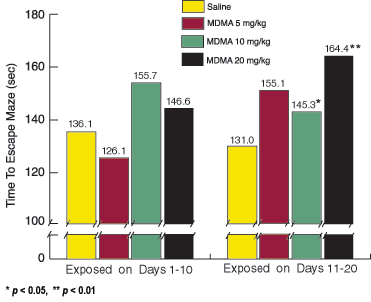Prenatal Exposure to Ecstasy May Impair Memory and Cognition
Download PDF Version What is PDF?
Jill S. Williams
Jill S. Williams is a Contributing Writer for NIDA NOTES.
Source: NIDA NOTES, Vol. 17, No. 3, October, 2002
Public Domain
Table of Contents (TOC)
IntroductionChapter 1: Timing and Vulnerability
Chapter 2: Testing for Learning, Memory
Chapter 3: Comparing Infant Versus Adult Exposure
References
Dr. Harry Broening, Dr. Charles Vorhees, and colleagues at the Cincinnati Children’s Research Foundation and the University of Cincinnati have demonstrated that rats exposed to MDMA -- ecstasy -- during the developmental period corresponding to the third trimester of human pregnancy suffer memory and learning deficiencies that persist into adulthood.
Scientific studies have already established that ecstasy users are at risk for dehydration, hypertension, hyperthermia, and heart or kidney failure. The drug also has been shown to damage nerves in the brain’s serotonin system and appears to produce long-term deficits in memory and cognition. The new study suggests that unborn children of ecstasy users may suffer deleterious effects that last into adulthood. "The possibility that these findings in rats may also apply to humans raises a concern because this drug, which is incorrectly perceived as safe by many of its proponents, is sometimes being used by young women who are pregnant," says Dr. Jerry Frankenheim of NIDA’s Division of Neuroscience and Behavioral Research.
Animals Exposed to MDMA Take Longer To Escape Multiple-T Water Maze
 Adult rats that had been exposed to MDMA doses of 10 or 20 mg/kg body weight (comparable to doses used by human MDMA abusers) on days 11 to 20 after birth (a period comparable to late in the third trimester of human pregnancy) took significantly longer to escape the multiple-T water maze than did animals exposed to saline solution. No statistically significant increase in escape times was observed among rats exposed on days 1 to 10 after birth.
Adult rats that had been exposed to MDMA doses of 10 or 20 mg/kg body weight (comparable to doses used by human MDMA abusers) on days 11 to 20 after birth (a period comparable to late in the third trimester of human pregnancy) took significantly longer to escape the multiple-T water maze than did animals exposed to saline solution. No statistically significant increase in escape times was observed among rats exposed on days 1 to 10 after birth.
In designing the current study, the researchers drew on previous studies by Dr. Vorhees on the effects of methamphetamine exposure on rodent brain development. These studies identified specific periods late in rodent brain development -- days 11 to 20 after birth, which are analogous to late third-trimester human fetal brain development -- in which the brain is quite vulnerable to methamphetamine-induced impairments of spatial learning and memory. The question became, can related drugs, such as MDMA and other synthetic stimulants, also cause such impairments?
Dr. Vorhees and his colleagues decided to test the effects of MDMA administered to rats at this same crucial 11 to 20 days postnatal developmental period and to a comparison group of rats on days 1 to 10 after birth (comparable to early third trimester of human pregnancy). According to Dr. Vorhees, the dosages given to rats in the study are equivalent to a 110-lb woman taking 25 mg, a common dose for MDMA users, up to 250 mg, an amount sometimes reached or exceeded by chronic abusers.
When the rats reached young adulthood, the researchers put them through a series of maze and swimming trials to assess the effects of MDMA exposure on learning and memory. An initial test revealed no significant differences between the MDMA-exposed rats and the controls in terms of swimming performance or motivation to escape from the water. Next, animals were evaluated in a test of sequential learning called the multiple-T (Cincinnati) water maze. The rats had to search through nine decision points to find their way through the maze and out of the water. The researchers found that the rats exposed to MDMA on days 11 to 20 after birth made significantly more errors and took significantly longer to escape the maze than did either the MDMA-unexposed animals or those exposed to MDMA on days 1 to 10 after birth.
"The animals exposed to MDMA during the critical 11 to 20 days postnatal brain development period cannot seem to eliminate errors the way normal animals do," says Dr. Vorhees. "The difference is the rate at which they learn. All of the animals eventually learned how to navigate the maze, but it took the MDMA-exposed animals significantly longer to do so."
The Morris hidden platform maze was used to further evaluate the animals’ spatial memory and cognitive abilities. A 6-foot diameter swimming pool was constructed and a small clear acrylic platform was placed so that the animals could escape if they found it. In increasingly difficult phases the rats had to find the platform when it was above the water, below the water, moved to a new location, or below the water and reduced in size. Memory trials were also performed with the platform removed. Animals exposed to MDMA on days 1 to 10 after birth performed as well as unexposed animals on the trials. However, the animals exposed to MDMA on days 11 to 20 after birth showed significant impairment of memory and spatial learning when the platform was submerged and on memory trials when the platform was removed, but no differences when the platform was above the water.
"These later trials test the animals’ ability to remember something in space," explains Dr. Vorhees. "We found that as we made the task harder, MDMA-exposed animals had a disproportionately harder time finding the platform. The harder the task was, the more their learning disability was revealed."
 Upon completion of the trials, the rats were sacrificed
and their brains were preserved for later analysis. The
researchers wanted to know if animals exposed to MDMA during
early brain development would show the same pattern of damage
to neurotransmitters that has been shown in adult animals
exposed to MDMA. They did not. "This was a surprise because
we didn’t find the same damage to neurotransmitters as was
found in previous studies of animals exposed to MDMA as
adults," says Dr. Vorhees. "Yet, the animals in the current
study still show cognitive impairment, as demonstrated by
their performance on the learning and memory trials." He
hypothesizes that a different mechanism is at work in animals
exposed to MDMA during brain development that later affects
their memory and learning ability. Future research will
focus on identifying this mechanism.
Upon completion of the trials, the rats were sacrificed
and their brains were preserved for later analysis. The
researchers wanted to know if animals exposed to MDMA during
early brain development would show the same pattern of damage
to neurotransmitters that has been shown in adult animals
exposed to MDMA. They did not. "This was a surprise because
we didn’t find the same damage to neurotransmitters as was
found in previous studies of animals exposed to MDMA as
adults," says Dr. Vorhees. "Yet, the animals in the current
study still show cognitive impairment, as demonstrated by
their performance on the learning and memory trials." He
hypothesizes that a different mechanism is at work in animals
exposed to MDMA during brain development that later affects
their memory and learning ability. Future research will
focus on identifying this mechanism.
Dr. Frankenheim points out that this research is a warning that what is happening in animals may also happen with people. "The work of determining what drugs of abuse do to fetuses when the mother takes them is very difficult. It is not yet known whether human fetuses exposed to MDMA will develop persistent memory and learning problems. However, these findings in rats raise the concern that MDMA may pose a previously unrecognized risk to the developing human brain," he says.
Future research will involve determining the effects of MDMA exposure at earlier points in fetal development, such as during the period corresponding to the first trimester in humans, when drug exposure is more likely for women who may not yet be aware that they are pregnant. The first trimester is also the developmental period when humans are most sensitive to neurotoxins.
Broening, H.W.; Morford, L.L.; Inman-Wood, S.L.; Fukumura, M.; and Vorhees, C.V. 3,4-methylenedioxymethamphetamine (ecstasy)-induced learning and memory impairments depend on the age of exposure during early development. Journal of Neuroscience 21(9):3228-3235, 2001.


